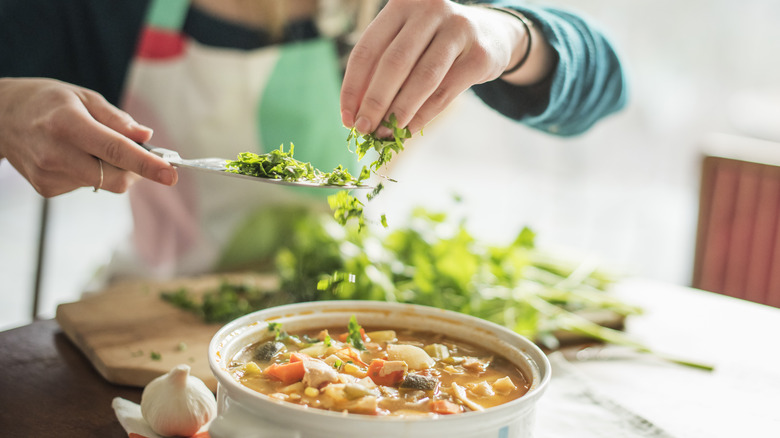Follow 2 Rules For The Most Aromatic Soups And Stews
For the best soups and stews, you need them to taste like more than meat, alliums, and vegetables. Otherwise, the flavor will be pretty flat and one-dimensional. Adding fresh herbs is one of the best ways to make these brothy, saucy dishes more dynamic and irresistible — but there is a right and wrong way to incorporate them. If you just toss in a handful of leaves at any given time, those herbs won't release much flavor, and will likely get buried under the more assertive ingredients.
It may seem counterintuitive, but you need to bruise herbs first to help them live up to their potential. Have you ever seen a bartender smack a sprig of mint before garnishing your mojito cocktail? They were bruising the leaves to release the oils, and that is exactly what you need to do when you make soups and stews. You can hit the herbs against your palm, press them between your fingers, or roll them around on your cutting board. You will see the color darken and the leaves will look slightly wet as their oils begin to release. Then, tear or chop the herbs as you normally would before stirring them into the pot.
For bright flavor, add bruised herbs at the end
While simmering herbs for a long time will release the oils into the broth as well, the overall taste will change. They will lose the vibrancy that makes them such a lovely addition. That is why the simple rule you should always follow when cooking with fresh herbs is to add them at the end of cooking (and bruise them before you do). That way, the bright aroma and taste is very pronounced when it comes time to serve. This is especially true for tender herbs, such as mint, parsley, cilantro, basil, dill, and tarragon. However, hardier herbs like rosemary, thyme, sage, and oregano can also be very finely chopped and added at the end for the same effect.
Another excellent way to impart plenty of herbaceous flavor is to add the herbs in two parts. Save the leaves to incorporate at the end, but add the stems to your soup or stew at the beginning. Just throw them in when you simmer the broth or stock, and they will impart a complex background flavor into the whole dish. And of course, an extra sprinkling of herbs on top of each bowl right before serving does wonders.


